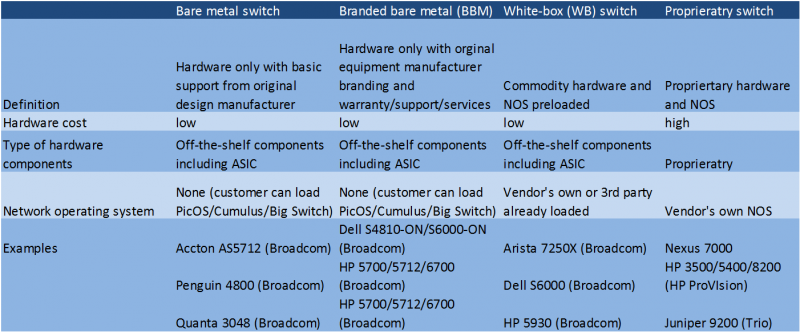What is the difference between white-box, bare-metal, branded bare-metal, and OEM network switches?
I’m getting a lot calls from clients who are using “white box” and “bare metal” interchangeably when discussing network switches. It might not seem like a big deal, but it is when customers are trying to accomplish a certain task and are examining the wrong products or don’t see the full picture. This is especially true when it comes to assuming that the hardware cost of an Accton 5712 switch is significantly lower than the hardware cost of Broadcom-based switches from Arista, Cisco, or HP. The reality is that pundits are mixing up terms and products.
Fundamentally, they are not making an apples-to-apples comparison and therefore are setting up the wrong expectations for customers. Forrester’s research document The Myth Of White-Box Network Switches dissects the cost of the Accton Edge-Core 5712 (Broadcom Trident II ASIC) switch layered with Cumulus Linux OS and compares this combination against a generic vendor switch built on Broadcom II ASIC, such as Cisco Nexus 3172PQ. We built a model showing the cost of goods sold from the components up and found less than a 5% difference between the switch from the original design manufacturer and traditional network vendor. This holds true when comparing other Accton Edge-Core switches against other traditional vendor Broadcom Trident II switches. The real cost is in the software, global distribution channel, compatibility testing between hardware and software, and global support. “The Myth Of White-Box Network Switches” gets into a lot more detail regarding actual costs.
That isn’t the point here. We wanted to provide some definitions and perspectives on what the market is offering so you can make the right comparisons and have a better understanding of what you are getting and not getting. A lot of customers don’t realize that vendors do have “off-the-shelf” switches–or as networking pundits like to call them, commodity, bare-metal, or white-box switches.You need to understand the nuances between them, and how those differences can impact your full business technology (BT) agenda. Building on Glen Kemp’s What separates white-box software from bare-metal switches?” article, here is Forrester’s taxonomy of the different types of offerings in the enterprise switch market:
- Proprietary switch. Most of the early switches were custom-built by vendors; however, over one-third of today’s vendor switch models are actually built completely with off-the-shelf commodity components. A switch is now considered customized or proprietary if the application-specific integrated circuit (ASIC) is custom-built for that purpose rather than a common merchant silicon ASIC from Broadcom, Marvell, or Intel. While custom switches have custom ASICs, the reality is that most of the components — the connectors, fans, PHYs, and capacitors — are off-the-shelf components. In general, economic sensibility drove the industry to transition commodity components inside network switches wherever possible. The difference mostly lies in whether it has merchant or custom ASICs to add value. Basically, most cost savings analysis has been done based on apples-to-oranges comparisons, white-box switches versus custom ASIC switches.
- Bare-metal switches. These are switches from original design manufacturers (ODMs) with no network operating system loaded on them. An ODM, such as Accton or Alpha Networks, is a company that designs and manufactures a product as specified by another company to be rebranded. While most network switch ODMs offer their products through a few distributors, Accton rebrands its switches as Edge-Core, global branded business from the Accton Technology Group. Warranties offered by ODMs are just hardware based and very basic. Customers must procure, separately, a third-party network operating system (NOS) — like Big Switch Light OS, Cumulus Linux OS,Pica8 PicOS — or build their own like Facebook did. Network operating system support and services must be obtained from the third-party NOS.
- White-box (off-shelf components) switch. Buyers tend to demonize vendors as companies that only offer proprietary solutions to lock customers in and charge them more. What many don’t know is that all vendors offer switches based on merchant silicon ASIC, and have for years. The vendors just didn’t advertise this very well. A majority of HP’s switch models have merchant silicon in them, and Arista’s entire product line uses merchant silicon. Within the last year, most of the vendors released switches based on the Broadcom Trident II silicon. Trust me when I say a lot of them are the same switch and come from the same ODM. Basically, white boxes are commodity-based bare-metal switches with a network operating system (third-party or traditional networking vendor) preloaded, such as Juniper’s OCX1100.
- Branded bare-metal switches. This one is a bare-metal switch that has an OEM brand on it (e.g., Dell and HP). Customers have to load their NOS. The difference between the two typically comes down to the OEM providing better service and support. HP offers a service and support package for customers to be the single point of contact for both NOS and hardware. The OEM’s channel presence allows much more geographic availability and customer care than the ODMs.
The options available to you are captured in the table below. You need to understand the differences before you can make informed decisions on which type of switch will be the best for your network infrastructure.

